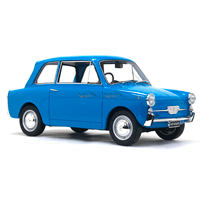
Catalog / Autobianchi
Autobianchi: Italian Automotive Innovation and Price Analysis
Autobianchi, a small but influential Italian automobile manufacturer, has left an indelible mark on the automotive world despite its relatively short lifespan. Founded in 1955 as a joint venture between Bianchi, Pirelli, and Fiat, Autobianchi quickly established itself as a pioneer in automotive design and technology.
The company's history began with the production of the Bianchina, a luxury version of the Fiat 500, in 1957. This small car, with its distinctive styling and upmarket features, set the tone for Autobianchi's future as a brand that combined Fiat's mechanical reliability with more luxurious and innovative designs.
In 1967, Autobianchi introduced one of its most famous models, the A112. This small hatchback, which remained in production until 1986, became an icon of Italian motoring. It was particularly popular among young drivers and women, thanks to its compact size, stylish design, and sprightly performance. The sporty Abarth versions of the A112 also gained a strong following in motorsport.
Autobianchi played a crucial role in Fiat's product development strategy. The brand was often used to test new concepts and technologies before they were introduced to the wider Fiat range. This was exemplified by the Primula, launched in 1964, which was one of the first cars to feature a transverse engine and front-wheel drive layout - a configuration that would later become standard across much of the automotive industry.
In 1969, Fiat took full control of Autobianchi, integrating it more closely with its own operations. Despite this, Autobianchi maintained its distinct identity and continued to produce innovative vehicles. The A111, introduced in 1969, was a larger family car that showcased Autobianchi's ability to compete in different market segments.
The 1980s saw the introduction of the Y10, a premium supermini that would carry the Autobianchi brand into its final years. Launched in 1985, the Y10 was sold as an Autobianchi in Italy and as a Lancia in other markets. This model embodied the brand's ethos of combining small car practicality with upmarket features and distinctive styling.
Autobianchi's end as a distinct brand came gradually. By the late 1980s, most of its models were being sold under the Lancia name outside of Italy. In 1996, the last Autobianchi-badged cars were produced, marking the end of this innovative marque.
Throughout its history, Autobianchi was known for several interesting facts:
- The company's logo, featuring the letter 'A' with a crown above it, reflected its aspiration to be a 'royal' or premium version of Fiat.
- Autobianchi was one of the first manufacturers to specifically target women as potential customers, with models like the Bianchina and A112.
- The A112 Abarth was a popular choice for rally racing, competing successfully in many events throughout the 1970s and 1980s.
- Autobianchi's Primula was not only innovative for its front-wheel-drive layout but also for its use of disc brakes on all four wheels - a rarity at the time.
Today, Autobianchi cars are cherished by collectors and enthusiasts, particularly in Italy. They represent an important chapter in automotive history, showcasing Italian design flair and technical innovation in a compact package.

